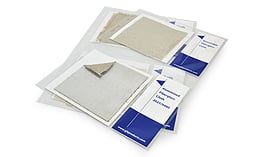Mechnical systems are often in need of insulation. These systems include such components as boilers, HVAC systems, piping and ducts. They are primarily found in commericial and industrial facilities where the goal is energy efficiency and emission reduction.
A more standard definition can be found in the National Mechanical Insulation Committee's Mechanical Insulation Design Guide, which states, "Mechanical insulation is defined to encompass all thermal, acoustical, and personal safety requirements in mechancial piping and equipment, both hot and cold."
There are a considerable number of choices in the selection of the right material to use in a mechanical insulation project. Below you will find what are considered the five core insulation categories for use in mechanical systems.
Cellular Insulation
Insulation composed of small, individual cells separated from each other. The cellular material may be glass or plastic such as polystyrene, polyurethane, polyisocyanurate, or elastomeric.
Fibrous Insulation
Insulation composed of small-diameter fibers that finely divide the air space. The fibers may be organic or inorganic and sometimes a binding agent may be used to hold the insulation together. Common types of fibrous insulation are silica, rock wool, slag wool, or alumina silica.
Granular Insulation
Insulation composed of small nodules that contain voids or hollow spaces. This type of insulation is often considered open cell as gases can be transfered between the individual spaces. Materials such as Calcium Silicate and molded perlite are considered granular insulation.
Flake Insulation
Composed of small particles or flakes which finely divide the air space and may not be bonded together. Examples of this type of insulation include vermiculite and expanded mica.
Reflective Insulation
Reflective insulation systems may consist of multiple parallel thin sheets or foil spaced to minimize convective heat transfer. This type of insulation is used in combination with other insulation materials. Generally, reflective insulation is used as some type of outer jacketing.
Always consult your mechanical design engineer to create the correct plan for your particular application. If you have questions about these materials, just ask us!



